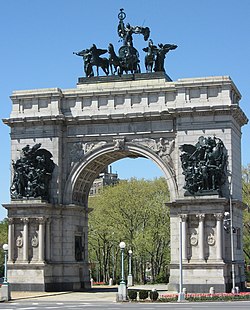| Soldiers' and Sailors' Arch | |
|---|---|
| Soldiers' and Sailors' Monument | |
 The arch as seen from the south end of Grand Army Plaza | |
| Type | American Civil War memorial |
| Location | Grand Army Plaza Brooklyn, New York, U.S. |
| Coordinates | 40°40′23″N 73°58′12″W / 40.6730°N 73.9699°W |
| Elevation | 135 ft (41 m) |
| Height | 80 ft (24 m) |
| Dedicated | October 21, 1892 |
| Built | 1889–1892 |
| Built for | City of Brooklyn |
| Restored | 1980; 2023–2024 |
| Architect | John H. Duncan |
| Sculptor | Frederick MacMonnies (sculptures), Philip Martiny (spandrels), Thomas Eakins and William Rudolf O'Donovan (bas-reliefs) |
| Owner | City of New York |
| Website | www |
| Designated | October 16, 1973 |
| Reference no. | 0821[1] |
Soldiers' and Sailors' Arch location in Brooklyn | |
The Soldiers' and Sailors' Arch is a triumphal arch at Grand Army Plaza in Brooklyn, New York, United States. Designed by John Hemenway Duncan and built from 1889 to 1892, the arch commemorates American Civil War veterans. The monument is made of granite and measures 80 feet (24 m) tall, with an archway opening measuring 50 feet (15 m) tall and 35 feet (11 m) wide. The arch also includes spandrels by Philip Martiny, equestrian bas-reliefs by Thomas Eakins and William Rudolf O'Donovan, and three sculptural groups by Frederick MacMonnies. It is one of New York City's three major triumphal arches.
The lowest portion of the arch is made of darker granite from Quincy, Massachusetts, above which is lighter-colored granite. There are four pedestals, two each facing north and south; the northern pedestals are empty, while the southern pedestals contain sculptural groups by MacMonnies, depicting the United States Army and United States Navy. The bas-reliefs within the archway opening depict Abraham Lincoln and Ulysses S. Grant on horseback, and the archway opening has a coffered ceiling. The spandrels above the arch contain representations of victory, as well as the seals of New York state and Brooklyn. On the roof is an observation deck and a quadriga, also designed by MacMonnies. Inside are stairways to the observation deck, as well as a room just beneath the roof.
After the Civil War, the then-independent city of Brooklyn planned a grand memorial to Union Army soldiers, though no major monument was built for two decades. The arch was proposed in 1888, and Duncan was selected as the arch's designer following an architectural design competition. The cornerstone of the arch was laid on October 30, 1889, and the arch was dedicated on October 21, 1892. Additional art was installed over the following decade. The arch was used for various events during the 20th century and was designated as a New York City landmark in 1973. The arch and its sculptures have been renovated several times over the years, including in 1980 and 2023–2024.
